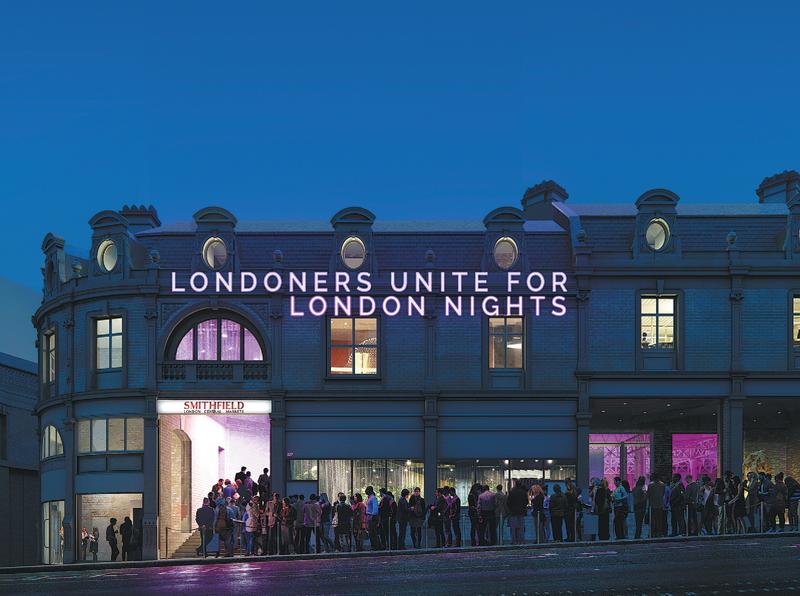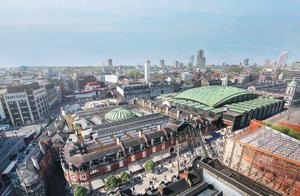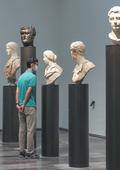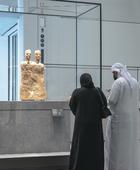Institutions boost cyberspace presence during pandemic
 An artist's impression of people lining up to attend an evening activity at the new Museum of London venue in Smithfield. (PHOTO PROVIDED TO CHINA DAILY)
An artist's impression of people lining up to attend an evening activity at the new Museum of London venue in Smithfield. (PHOTO PROVIDED TO CHINA DAILY)
The COVID-19 pandemic has forced museums worldwide to close for some time, but Ke Tao, a 26-year-old working for an internet company in Shenzhen, Guangdong province, visits a number of these institutions three to four times a week, thanks to digital technology.
Innovative solutions have enabled the product manager to take virtual tours of well-known museums in China and farther afield.
The institutions she visits include the Palace Museum in Beijing, the Metropolitan Museum of Art in New York, the Royal Picture Gallery Mauritshuis in the Netherlands and the Seoul Museum of History in South Korea.
"Many museums have impressed me with their audience-friendly websites, variety of exhibits and comprehensive explanations of artworks," Ke said.
"Some museums have held livestreamed shows, allowing audiences to appreciate exhibitions by following virtual guides and interacting online with other visitors, which has been a novel experience for me."
According to a report by the United Nations Educational, Scientific and Cultural Organization, museums have been badly affected by the pandemic, with nearly 90 percent of them, more than 85,000 worldwide, having to close temporarily due to measures taken to combat COVID-19.
More than 10 percent of them may never reopen.
Museums were quick to react to the pandemic by developing their internet presence to maintain links with the public and take advantage of the digitization and digital communication work carried out on their collections.
This work includes online collections, 360-degree virtual tours, online publications and digital exhibitions, according to the report.
Many museums have seen a substantial rise in the number of visitors to their websites during lockdowns.
For example, the Louvre Museum in Paris saw visits to its website rise tenfold in the first few days of the lockdown in France. Visitor numbers were later reported to have reached a level three times higher than average, the report said.
However, the digital divide is now more apparent than ever, as only 5 percent of museums in Africa and Small Island Developing States are able to provide online content, according to the report.
 An aerial view of the Louvre Abu Dhabi in the capital of the United Arab Emirates. (PHOTO PROVIDED TO CHINA DAILY)
An aerial view of the Louvre Abu Dhabi in the capital of the United Arab Emirates. (PHOTO PROVIDED TO CHINA DAILY)
Forced to close
Sharon Ament, director of the Museum of London, said that in March last year the institution was forced to close with almost no notice. Along with museums worldwide it immediately lost income generated from hiring out the venue, corporate hospitality, retail outlets, ticket sales, and restaurant and cafe takings.
"This was unprecedented and never featured on our annual risk register," Ament said, adding that in the 12 months from March last year the museum was only open for just over 13 weeks.
When it was allowed to open, the institution experienced low visitor numbers, averaging only 20 percent of the previous year's performance.
Ament said about 50 percent of its visitors came from overseas, but this flow dried up immediately.
"Our self-generated income streams, which form an important source of funding for the museum, producing £3.5 million ($4.2 million) each year, were badly affected," she added.
As the museum was unable to provide its usual services to visitors, it turned to displays aimed at online audiences.
It created a new digital strategy, Project Doors Stay Open, which brought the museum and its activities to life online, repackaged content, and created and pooled ideas.
A particular highlight was the Great Fire of London livestreaming series for schoolchildren studying from home, which attracted more than 55,000 views in the launch month. Broadcasters using this content netted 500,000 views and 23,189 interactions, Ament said.
"This was one of our most successful times last year and was an important way for the museum to maintain its engagement with schoolchildren and families in particular," she added.
In the lead-up to Christmas, the museum focused on supporting its online shop and generating donations, prompting a rise of nearly 102 percent in visits to the shop compared with October, and a 271 percent rise in online revenue, Ament said.
"Now, more than ever, museums play a crucial role in society as spaces that are responsive to the world around them," she said, adding that a new Museum for London at West Smithfield will deliver significant economic and social benefits, contributing to the city's post-pandemic recovery.
Ament said that the latest government guidelines indicate that the museum can reopen in mid-May.
"There are many challenges that lie ahead, but with the vaccination program continuing at an impressive rate, we're hoping to welcome visitors from the UK and around the world once again," she said.
 The Museum of London. (PHOTO PROVIDED TO CHINA DAILY)
The Museum of London. (PHOTO PROVIDED TO CHINA DAILY)
Manuel Rabate, director of Louvre Abu Dhabi in the United Arab Emirates, said that in March last year the pandemic forced the museum to close for 100 days, which was "not an easy decision and a time of real sadness".
"Along with our colleagues across the globe, the pandemic has meant a drop in visitor numbers," he said."An average of 70 percent of our visitors were tourists pre-COVID-19, and 30 percent were from the local community. Now, these proportions have been reversed."
Rabate said that when preparations were being made to reopen Louvre Abu Dhabi, "an incredible amount of support" was received from museums in China, which were "ahead of the COVID-19 curve "and able to offer advice on strategy.
"In the galleries, we used modeling to predict and adjust capacity, identify potential bottlenecks, and ensure we were able to regulate traffic to properly maintain social distancing," he said.
The museum also used digital technology to continue providing entertainment and education to local and global visitors of all ages.
"Looking back to the beginning of the pandemic, there was less urgency to digitize our offerings, but when COVID-19 hit, we realized we needed to be quick and agile in adapting to the situation,"Rabate said.
Within weeks of the pandemic emerging, the museum launched 22 virtual programs that attracted more than 2.2 million online users in the past year alone. The programs included WE ARE NOT ALONE by Soundwalk Collective, a futuristic audio-visual experience allowing visitors to appreciate the museum's architecture online.
However, Rabate said nothing can compare with visiting the museum in-person.
In addition to being able to safely welcome back visitors in Abu Dhabi, the museum has new attractions such as Yoga Under the Dome, kayaking tours to view the institution from the water, and a fine-dining experience at Le Fouquet's, the Paris restaurant.
Rabate said he is optimistic about the future, especially as the availability of COVID-19 vaccines means that many visitors may be able to come to Abu Dhabi soon.
"The long-term prospect for museums will certainly be a hybrid model of in-person and digital initiatives," he said.
"While I believe in the importance of looking at physical objects and artworks, virtual programming remains crucial, and to date, it has allowed us to reach a larger and more geographically diverse audience."
Engagement with and comments on virtual initiatives have been "exceptional", he said, adding that the museum opened its first international exhibition, Abstraction and Calligraphy-Towards a Universal Language on Feb 17. The display is scheduled to run until June 12. A virtual experience for this exhibition will also be launched in coming weeks, he said.
 Louvre Abu Dhabi reopens to the public in summer last year. (PHOTO PROVIDED TO CHINA DAILY)
Louvre Abu Dhabi reopens to the public in summer last year. (PHOTO PROVIDED TO CHINA DAILY)
Inevitable trend
Han Bing, chief researcher of culture and entertainment for global consultancy Roland Berger, said going digital is an inevitable trend for museums, and the pandemic has accelerated this.
"Compared with offline museums, virtual institutions are not limited by space, can be more expressive by using technologies, and have a stronger interaction with users," she said.
"Moreover, virtual museums can experiment with innovation to offer more flexible, interesting and entertaining forms of education for their audiences."
Han added that while the pandemic will not totally change people's habit of visiting museums, it may bring a certain degree of change.
"In the post-pandemic era, the positioning of offline and virtual museums will be different. Both online and offline models have their advantages and disadvantages, and they will certainly coexist, with a relatively clear division of functions and features."
While some people will find that virtual tours provide novel experiences and convenience, others may prefer visiting museums in-person to view their collections, she said.
 Louvre Abu Dhabi reopens to the public in summer last year. (PHOTO PROVIDED TO CHINA DAILY)
Louvre Abu Dhabi reopens to the public in summer last year. (PHOTO PROVIDED TO CHINA DAILY)
Underlying aims
Richard Whiddington, senior staff writer at Jing Culture and Commerce in New York, which specializes in cultural strategies, technologies and solutions, said the pandemic has not changed the underlying aims of museums to serve, connect and educate audiences, and to protect their collections for future generations.
"For many museums, however, the way in which they accomplish their missions is changing. Digital is pivotal to these efforts," he said.
Whiddington added that adopting digital strategies is in no way "incongruous with curating offline exhibitions" and the key will be finding a balance and integrating offline and online experiences.
Ke, the internet company worker in Shenzhen, said that although she enjoys the convenience and interaction of visiting museums online, she is looking forward to experiencing them in-person again when the institutions and international borders reopen.
"Museums are the soul of a city. Traveling to a city and experiencing its cultural atmosphere can provide visitors with a richer sensory experience," she said.
Yang Ran contributed to this story.


